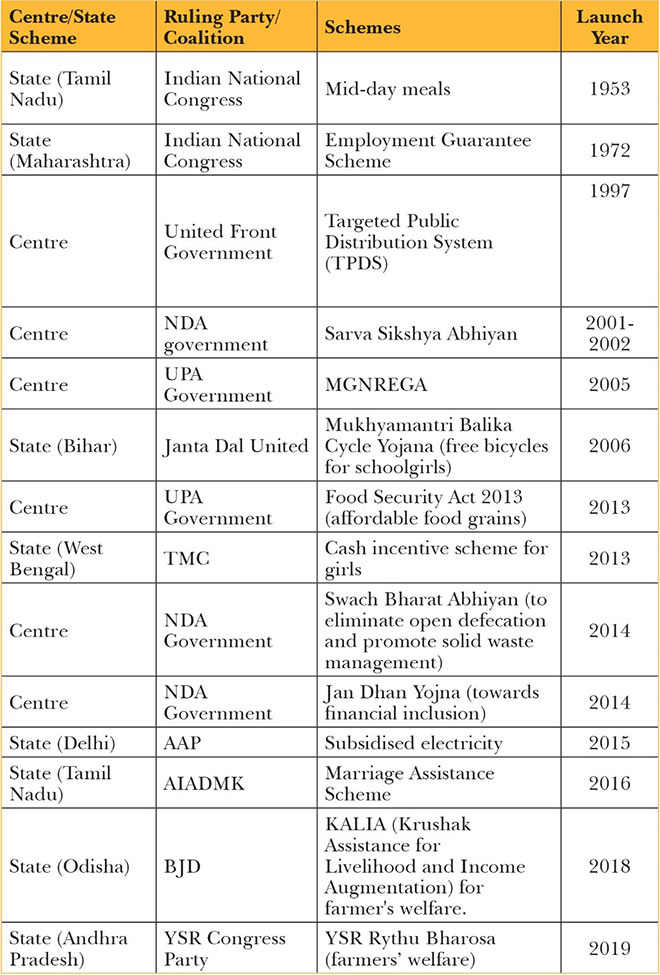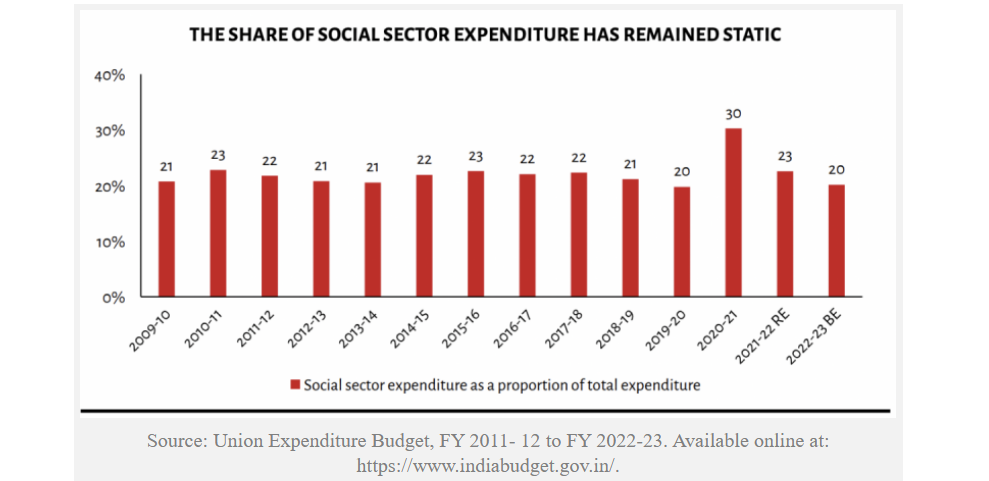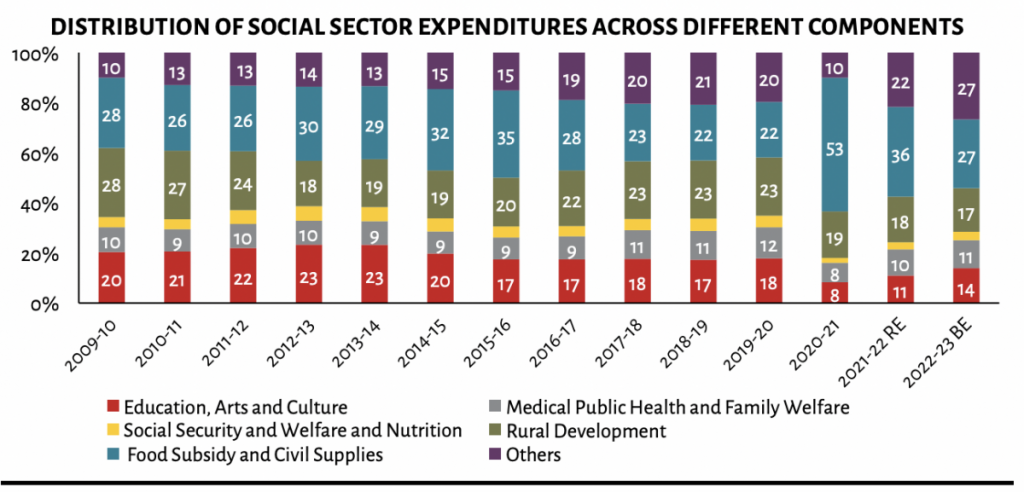Governance
From Welfarism to Well-Being
- 15 Nov 2023
- 12 min read
This editorial is based on “The welfare programme economists loved to hate” which was published in Hindustan Times on 14/11/2023. It talks about the success of the Mahatma Gandhi National Rural Employment Guarantee Scheme (MGNREGS) which has proven to be a vital rural economic lifeline despite the initial concerns of several economists in India.
For Prelims: Mahatma Gandhi National Rural Employment Guarantee Scheme (MGNREGS), World Bank, Public Distribution System (PDS), Freebies, Indian Constitution, Welfare Schemes, Zamindari, Directive Principles of State Policy, Mid Day Meal Scheme, KALIA Scheme, Jan Dhan Yojana.
For Mains: About Welfare Schemes, Arguments in Favor of Welfare Schemes in India, Arguments Against the Welfare Scheme in India, Way Forward to Go from Welfare to Well-being.
Recent research has shown that the Mahatma Gandhi National Rural Employment Guarantee Scheme (MGNREGS) operates as a reliable social safety net, addressing economic distress in rural households.
- Despite economist criticism and fears of distorting rural labor markets, MGNREGS has become an automatic stabilizer rather than a destabilizing force.
- This research prompts critics to recognize the transformative capacity of welfare schemes to positively impact the lives of India's most vulnerable populations.
What are Welfare Schemes?
- About:
- Welfare schemes refer to government programs or initiatives designed to provide financial, social, or other forms of assistance to individuals or groups facing economic, social, or health-related challenges.
- These schemes aim to improve the well-being and quality of life for citizens, often focusing on vulnerable or disadvantaged populations.
- Public Welfare in India:
- In accordance with Part IV of the Indian Constitution, which outlines the Directive Principles of State Policy, underscores India is a 'welfare state'.
- For this, several legislative efforts have been made to eliminate practices like untouchability, forced labor, and Zamindari.
- Over time, the government has established fair-price shops, providing essential commodities at affordable rates to benefit economically disadvantaged and marginalized sections of society.
- Measures have been implemented to reserve seats for Scheduled Castes and Scheduled Tribes across various domains such as government jobs, educational institutions, Lok Sabha, and Vidhan Sabha.
- Key Welfare Schemes Introduced by Centre and States in India:

- Social Sector Expenditure Trends in India:
What are the Arguments in Favor of Welfare Schemes in India?
- Poverty Alleviation:
- Welfare schemes aim to reduce poverty by providing financial assistance, employment opportunities, and essential services to those in need.
- Welfare schemes do not wipe away poverty or vulnerability but they reduce them significantly so that a person availing of these schemes can lead a life of dignity and escape from extreme hunger and poverty.
- Social Equity:
- Welfare schemes provide targeted assistance to disadvantaged groups, welfare schemes work towards reducing economic and social inequalities.
- Reservation policies and targeted welfare initiatives empower historically marginalized groups, offering them opportunities for education, employment, and political participation.
- Human Development:
- Welfare programs often focus on education, healthcare, and skill development, contributing to the overall human development of the population.
- Health-focused welfare schemes enhance public health outcomes by providing access to medical facilities, immunization, and preventive healthcare measures.
- By investing in education and skill development, welfare schemes contribute to an increase in the productivity of the workforce, which benefits the overall economy.
- Political Stability:
- By addressing socio-economic challenges, welfare schemes contribute to social stability and harmony, reducing the likelihood of unrest and social discontent.
- Meeting the socio-economic needs of the population through welfare schemes can contribute to political stability by addressing grievances and fostering a sense of inclusivity.
- Crisis Management:
- Welfare schemes act as safety nets during economic downturns, natural disasters, or other crises, providing relief and support to affected individuals and communities.
What are the Arguments Against the Welfare Scheme in India?
- Debate on Welfare Schemes vs. Freebies:
- The difference between freebies and welfare schemes is not always clear, but a general way to distinguish them is by their long-term impact on beneficiaries and society. Welfare schemes have a positive impact, while freebies can create dependency or distortions.
- A report by the NITI Aayog criticized that freebies such as laptops given by the state government diverted funds from more urgent needs such as improving school infrastructure, teacher quality, or learning outcomes.
- Financial Burden:
- The extensive welfare programs can impose a significant financial burden on the government, potentially leading to budgetary constraints and fiscal challenges.
- Some argue that the long-term sustainability of certain welfare programs is questionable, especially if they create a perpetual need for government subsidies without encouraging self-sufficiency.
- Dependency Culture:
- The prolonged reliance on welfare may foster a culture of dependency, discouraging self-reliance and individual initiative among recipients.
- Opponents argue that overly generous welfare provisions might discourage people from actively seeking employment, potentially eroding the work ethic within the population.
- Corruption and Leakage:
- Concerns exist about corruption and leakages in the implementation of welfare schemes, with funds intended for beneficiaries being misappropriated through fraudulent practices.
- In some cases, critics argue that there is limited accountability in the implementation and monitoring of welfare schemes, leading to a lack of transparency and oversight.
- Inefficiency and Bureaucratic Hurdles:
- There are concerns that welfare benefits may not always reach the intended beneficiaries, leading to ineffective targeting and leaving out those who genuinely need assistance.
- There are concerns that bureaucratic inefficiencies, red tape, and complex procedures can hinder the effective implementation of welfare programs, leading to delays and inequitable distribution.
- Market Distortions:
- Some argue that certain welfare measures, such as price controls or subsidies, may distort market mechanisms and impede the natural functioning of the economy.
- Some argue that certain welfare measures, if not managed carefully, can contribute to inflationary pressures by injecting excess money into the economy.
- Political and Social Division:
- Critics suggest that politicians may use welfare schemes for political gain, manipulating them to secure votes rather than implementing them based on genuine developmental needs.
- Some argue that certain reservation policies may create social divisions and hinder meritocracy, leading to resentment among various sections of society.
- A survey by the Association for Democratic Reforms showed that 41% of voters in Tamil Nadu considered freebies as an important factor in voting.
What Should be the Way Forward to Go from Welfare to Well-being?
- Draw a Line Between Welfare and Freebies:
- Freebies must be understood from an economic perspective and connected to taxpayers' money.
- Welfare policies should be based on evidence and data to ensure that resources are directed where they are most needed.
- Prioritize Holistic Development:
- Prioritize holistic development that goes beyond addressing immediate needs. Policies should focus on education, healthcare, skill development, and infrastructure to create a foundation for long-term well-being.
- Design programs that empower individuals by providing them with the necessary skills and knowledge to secure sustainable livelihoods.
- Encourage Entrepreneurship and Employment Opportunities:
- Encourage entrepreneurship and create an environment that facilitates job creation.
- This involves supporting small and medium enterprises, promoting innovation, and fostering a business-friendly ecosystem.
- Empower Community Participation:
- Empower local communities to identify their needs, propose solutions, and actively contribute to their own development.
- Foster collaborations between the public and private sectors. Public-private partnerships can bring together resources, expertise, and innovation to address complex challenges more effectively.
- Promote Inclusivity:
- Ensure inclusivity by addressing the needs of vulnerable and marginalized populations. No one should be left behind in the pursuit of overall well-being.
- Ensure gender equality in all aspects of development. Empower women economically, socially, and politically as their well-being is intricately linked to the well-being of the entire community
- Strengthen social security nets that provide a safety cushion during challenging times. Ensure these nets are efficient, transparent, and targeted to reach those who need them the most.
- Integrate Environmental Sustainability:
- Integrate environmental sustainability into development initiatives.
- A focus on eco-friendly practices and sustainable resource management contributes to both individual and community well-being.
Conclusion:
Transitioning from Welfarism to Well-being requires a comprehensive and integrated approach that focuses on empowerment, sustainability, and the overall improvement of the quality of life for individuals and communities. In terms of policy, the Capability Approach rightly suggests a focus on expanding people's capabilities and freedoms rather than merely increasing their income.
Drishti Mains Question:
Q. What are the key challenges and debates surrounding the formulation and implementation of welfare policies in India? Suggest policy strategies that can empower the holistic development of individuals and communities in the country.
UPSC Civil Services Examination, Previous Year Question (PYQ)
Prelims:
Q.With reference to ‘Stand Up India Scheme’, which of the following statements is/are correct? (2016)
- Its purpose is to promote entrepreneurship among SC/ST and women entrepreneurs.
- It provides for refinance through SIDBI.
Select the correct answer using the code given below:
(a) 1 only
(b) 2 only
(c) Both 1 and 2
(d) Neither 1 nor 2
Ans: C
Mains:
Q.‘Despite the implementation of various programmes for eradication of poverty by the government in India, poverty is still existing’. Explain by giving reasons.(2018)









